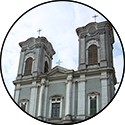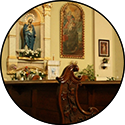The Canon’s Corridor

From an architectural point of view, the Canon’s Corridor consists of 10 buildings built together, yet independent of each other. Although these buildings were not built at the same time, the style of their facades (apart from the small details) still shows unity. Its designer and contratcor are both unknown. The ground floor arcade is uniform in both architecture and style. Looking at the ten canonical dwellings built between 1750 and 1875, they represents the classicised baroque in their style, and although completely lacking the exaggerated baroque ornamentation, it is still one of the most beautiful baroque buildings in the city.
From the middle of the 18th century, the current Hungarian rulers favorably rewarded church figures who excelled in scientific or literary life with one of the canonical chairs in Oradea.
Thanks to this, the Canon’s Corridor has had many famous inhabitants in the last 250 years: György Pray, the father of scientific Hungarian historical research, István Schönvizner and Flóris Rómer, the creators of Hungarian archeology, György Fejér, a prominent cultivator of Hungarian diplomacy, or Vilmos Fraknói, founder of the Hungarian Historical Institute and Art House in Rome.
From an architectural point of view, the Canon’s Corridor consists of 10 buildings built together, yet independent of each other. Although these buildings were not built at the same time, the style of their facades (apart from the small details) still shows unity. Its designer and contratcor are both unknown. The ground floor arcade is uniform in both architecture and style. Looking at the ten canonical dwellings built between 1750 and 1875, they represents the classicised baroque in their style, and although completely lacking the exaggerated baroque ornamentation, it is still one of the most beautiful baroque buildings in the city.
From the middle of the 18th century, the current Hungarian rulers favorably rewarded church figures who excelled in scientific or literary life with one of the canonical chairs in Oradea.
Thanks to this, the Canon’s Corridor has had many famous inhabitants in the last 250 years: György Pray, the father of scientific Hungarian historical research, István Schönvizner and Flóris Rómer, the creators of Hungarian archeology, György Fejér, a prominent cultivator of Hungarian diplomacy, or Vilmos Fraknói, founder of the Hungarian Historical Institute and Art House in Rome.







